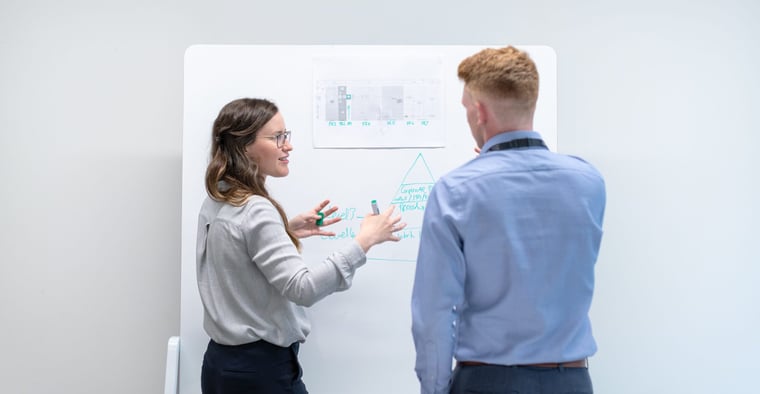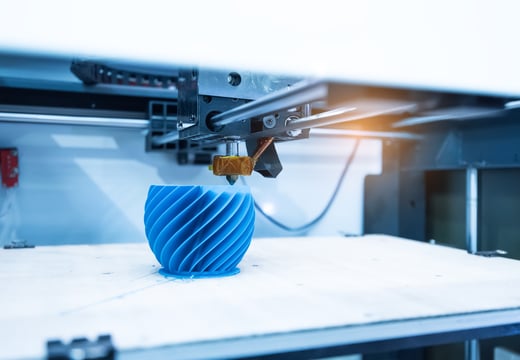
Challenging preconceptions: the importance of understanding what you do & don’t know
May 2021
By Simon Copley – Mechanical Engineer at 42 Technology
Challenging preconceptions: the importance of understanding what you do, and don’t, know

The biggest expert on any product or production process is almost always the manufacturer. After all, they developed it, and their employees work on it day in, day out.
So when a new challenge arises – which could be anything from creating the next generation product, or stopping an issue that’s increasing wastage or the reject rate – the obvious first step is to dive straight in. After all, surely the manufacturer knows exactly what the problem is and has the knowledge to solve it?
But diving straight in means the team is relying on a large amount of background experience, without consciously acknowledging that not all of this experience is relevant to the current challenge. And lots of common knowledge in the company is second hand, built up over the years and passed among colleagues.
The problem with experience
If no-one in the process challenges the relevance of the group’s common knowledge, implicit assumptions can sneak in alongside proven truths. Most of these implicit assumptions are accurate, but crucially, not all. Examples include:
- What a successful solution looks like, e.g. “The new product should look and perform like the old one, because the old way is still the best way.”
- What the scope of change should be, e.g. “The production line will be easiest to fix if we only consider changing this single step, as we’re sure that’s where the root of the problem is. It will be too expensive to change anything else.”
- Which options can be instantly ruled out, e.g. “Nice idea, but someone ran a test like that 5 years ago. It didn’t go anywhere in the business, so let’s not bother to tread old ground.”

To be clear, it’s often only a small number of these assumptions that turn out not to be accurate. The experts are still the experts after all. But the key step is to recognise which small percentage of the prior knowledge is artificially limiting the scope of what an innovative solution could be.
The big risk is that incorrect assumptions turn into inappropriate requirements, and the problem becomes over constrained. Developing working solutions then becomes much more expensive and time consuming than necessary.
There are many ways to ensure that your team isn’t over constraining the problem with false assumptions:
Introducing a systematic approach
One great approach is to deconstruct the problem to its root causes. This is essential to allow the team to sift through their prior experience and previous development efforts so that their perspective isn’t clouded by examples and data points that aren’t strictly relevant.
A solution neutral problem statement is a good way to do this. Creating one together as a team at the beginning of the project keeps everyone aligned on what the problem to be solved actually is. The aim is to describe the challenge at a fundamental level. Rather than thinking “what do we need the solution to look like?”, instead consider “what do we need the solution to achieve?”. This avoids the team missing out on completely out of the box ideas with great potential.
But without understanding which assumptions are and aren’t valid, breaking down the problem right to its fundamentals is difficult. The team may focus on the wrong piece of equipment, or component and spend a large amount of resources investigating and testing innovative dead ends, because assumptions weren’t challenged early on.

Drawing from cross-sector experience
Once the challenge has been boiled down to its core problem, its often the case that inspiration can be drawn from other industries where a similar problem has been solved. Key prompts to ask the team are “How do other industries approach this process?”, or “What other problems have these constraints, and how are they solved?”.
The core project team may not be best placed for this, especially if they’ve been working closely on the product or process for many years. Having team members with cross-sector experience is crucial to bringing ideas across industry boundaries. If the organisation is large enough, involving engineers from other divisions or industries is the easiest step to take. Otherwise, the best choice is to bring in a skilled engineer or two from outside the organisation, especially if they have had exposure to a large number of industries.
One recent example of this came when tackling a challenge to dry a liquid coating on items moving on a production line. For various reasons the obvious solution, a conveyor-based oven, isn’t perfect.
The fundamental challenge boiled down to providing energy targeted to a small zone. Drawing parallels from other industries shows that this isn’t a new problem. Think about SLA 3D printing where a galvanometer is used to aim a laser along a defined path to fuse powder into a shaped part.
At worst, this might not be the best solution for the original drying problem - and this example, it wasn’t! But the example provides a good benchmark to challenge assumptions on what solutions will be technically feasible. It inspires the team to widen the scope of ideas. And at best, the analogous solution fits the current problem well, the team takes a shortcut, avoids reinventing the wheel, and saves time and development effort.
Bringing in a fresh pair of eyes

Bringing in a fresh pair of eyes is a great way to challenge the validity of assumptions early on. The best option is often a skilled engineer with a strong technical background. Crucially, with limited prior knowledge of the product in question. This could be a member of a different team within the organisation or somebody from outside.
This allows for a powerful team mix of experienced veterans and unconstrained newcomers that aren’t afraid to ask simple or naïve questions.
At 42 Technology, our team of engineers and physicists are frequently engaged by our clients to give a fresh perspective on difficult technical problems. In one project, we were engaged to devise ways to reduce the water consumption of a critical step on a manufacturing process.
We were able to challenge several assumptions about whether altering several steps would affect the quality of the final product. This allowed us to widen the scope of acceptable ideas.

By the end of the project, we’d uncovered the potential for large reductions, reliant on some small modifications to other stages on the production line.
This might not have been possible without bringing an outsider’s perspective to challenge the assumptions that had led to the original focus of the project.
Linking everything together
Remember
- Avoid over constraining your understanding of the initial challenge with flawed assumptions
- Ensure that the team is aligned on what the fundamental problem or aim is
- Look at how other industries solve similar challenges to inspire the team
- Get a fresh pair of eyes involved to add an outsider view to the team
Improving the development process in these ways is not just a theoretical exercise - it can lead to great results.
Working alongside our clients, we’ve used these techniques to help them unlock the next level of innovative ideas. This has led to new product formats, progress towards sustainability goals. And of course, significant energy savings and throughput improvements on numerous production lines.

If you would like to find out more please contact Simon:
answers@42T.com | +44 (0)1480 302700 | www.linkedin.com/in/simoncopley
Simon is a highly practical mechanical engineer with a multidisciplinary technical background. He he has used his skills in projects as varied as designing assembly jigs to reduce the manufacturing cost of an industrial communications device, developing tests to assess the durability of a surgical device, and evaluating the strength of IP held by a large manufacturer of consumer products.
Share this article:
Related Articles

Innovation, Product Design
Embracing innovation: the future of product development

Innovation, 2024 Technology Trends
AI powered innovation - the disrupting force transforming the market

Innovation, 2024 Technology Trends
Service-dominant logic - innovation process next steps

What will you ask us today?
We believe in asking the right questions to drive innovation; when we know the right questions, we generate the ideas to answer them.

